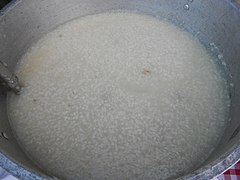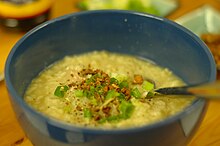


Basic lugaw
| |
| Alternative names | pospas, lugao |
|---|---|
| Course | Main dish |
| Place of origin | Philippines |
| Main ingredients | glutinous rice |
| Variations | arroz caldo, goto |
| Similar dishes | Congee |
Lugaw, also spelled lugao, is a Filipino glutinous rice dish or porridge. Lugaw may refer to various dishes, both savory and sweet. In Visayan regions, savory lugaw are collectively referred to as pospas. Lugaw is widely regarded as a comfort food in the Philippines.[1][2][3]
According to the National Commission for Culture and the Arts, lugaw is one of the earliest historically-documented dishes in the Philippines. The Vocabulario de la lengua tagala (1613) by Fr. Pedro de San Buenaventura, defines "logao" (Hispanized as "aroz guisado") as "rice mixed with [coconut] milk or water or of both (porridge)."[4][5]
Lugaw is traditionally made by boiling glutinous rice (Ilocano: diket ;Tagalog: malagkit; Visayan: pilit). Regular white rice may also be used if boiled with excess water. The basic version is sparsely spiced, usually only using salt, garlic, and ginger; or alternatively, sugar. Heartier versions are cooked in chicken, fish, pork or beef broth. It is regarded as a comforting and easy-to-digest food, typically prepared for breakfast and during cold and rainy weather. It is also commonly served to people who are sick or bedridden, and to very young children and the elderly.[6][7]
Lugaw is usually eaten hot or warm, since the gruel congeals if left to cool. It can be reheated by adding a little bit of water.[8][9][10][11] Dessert versions can be eaten cold or even partly frozen.[12]
Lugaw can be paired or augmented with numerous other dishes and ingredients.

Most savory versions of lugaw are derived from or influenced by Chinese-style congee, introduced by Chinese-Filipino migrants. It has diverged over the centuries to use Filipino ingredients and suit the local tastes. Filipino savory lugaw are typically thicker than other Asian congees because they use glutinous rice. They are traditionally served with calamansi, soy sauce (toyo), or fish sauce (patis) as condiments[13][14] Savory lugaw are usually paired with meat or seafood dishes. The most common being tokwa't baboy (cubed tofu and pork).[6][7]

Sweet versions of lugaw are more characteristically Filipino. They include:
The lugaw has been widely associated with the political camp of Philippine Vice President Leni Robredo, originating from her 2016 election campaign during which Robredo's supporters sold the rice porridge as part of a fundraising effort.[20] Robredo's detractors and internet trolls have pejoratively used the tags "Leni Lugaw" or the "Lugaw Queen" after photos of her serving lugaw circulated online.[21] In response, Robredo has since adopted the tag during political events and campaigns, including serving lugaw to attendees of her 2022 Philippine presidential election bid announcement.[22]
Other Philippine rice cooking techniques:
|
| |||||||||||
|---|---|---|---|---|---|---|---|---|---|---|---|
| Main dishes |
| ||||||||||
| Noodles and pasta |
| ||||||||||
| Sausages |
| ||||||||||
| Lumpia and turón |
| ||||||||||
| Breads, cakes, and pastries |
| ||||||||||
| Desserts |
| ||||||||||
| Condiments and ingredients |
| ||||||||||
| Beverages |
| ||||||||||
| |||||||||||